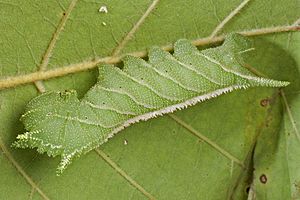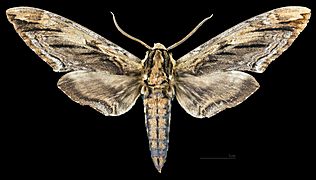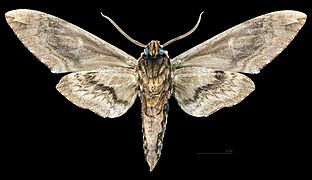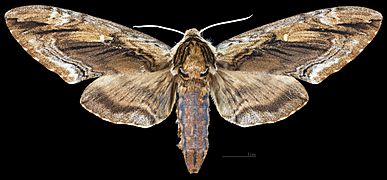Elm sphinx facts for kids
{{Speciesbox | name = Elm sphinx | image = - 7786 – Ceratomia amyntor – Elm Sphinx Moth (43246522724).jpg | image_caption = | taxon = Ceratomia amyntor | authority = (Geyer, 1835) | synonyms =
- Agrius amyntor Geyer, 1835
- Ceratomia quadricornis Harris, 1839
- Ceratomia ulmi Boisduval, 1875
} The Elm Sphinx (scientific name: Ceratomia amyntor) is a cool North American moth. People also call it the Four-horned Sphinx because of its unique look. A scientist named Carl Geyer first described this moth in 1835. Its wings can spread out about 3+1⁄4 to 4+1⁄2 inches (8.2 to 11.5 cm) wide.
As its name suggests, the young moths, called caterpillars, love to eat leaves from elm trees (Ulmus). But they also munch on birch (Betula), basswood (Tilia), and cherry (Prunus) trees. When a caterpillar is ready to change, it crawls down its host tree. It then burrows into the soil to become a pupa. If it's late in the year, it might even spend the winter underground.
Gardeners should know about these caterpillars! They have a huge appetite. Just one caterpillar can eat a lot of a plant's leaves and even its juicy stems.
Contents
Where the Elm Sphinx Lives
The Elm Sphinx moth, C. amyntor, can be found across a wide area. It lives from Nova Scotia in the east, all the way west to Alberta and western North Dakota and Colorado. Southward, you can find it in central Florida, along the Gulf Coast, and in states like Texas, Louisiana, and New Mexico.
Is the Elm Sphinx Moth in Danger?
Good news! This moth species is not considered to be threatened. There are plenty of them around.
The Elm Sphinx Life Cycle
Adult C. amyntor moths fly at different times depending on where they live. In the northern parts of their home range, they usually fly once a year, from June to July. Further south, they have two flight periods later in the year. In Louisiana, scientists have even seen them fly five times a year, from March to October!
Eggs
The Elm Sphinx moth lays tiny, see-through, lime-green eggs. They are usually placed on the underside of host tree leaves. After the caterpillars hatch, the empty eggshells look clear and shiny.
Larva (Caterpillar)
Elm Sphinx caterpillars come in two main colors. Some are green, while others are dark. The dark ones can be shades of brown, orange, or even a pinkish-brown. Caterpillars grow through five stages, called instars, in about one month.
When a caterpillar first hatches, it's the same green color as its egg. As it grows through each instar, its body changes. The caterpillar gets four long, horn-like bumps above its head. It also has a tail horn. These four horns are why it's sometimes called the "four-horned sphinx."
Pupa
Like other moths in the Sphingidae family, C. amyntor caterpillars have a "wandering" phase. This means they stop eating and start looking for a place to change. They burrow into the soil to become a pupa. Before turning into a pupa, the caterpillar shrinks quite a bit. Then, it sheds its last skin, revealing its hard, shell-like pupa.
Imago (Adult Moth)
The adult Elm Sphinx moth is mostly gray-brown. Its forewings have wavy patterns. In the middle of the upper forewings, like other Ceratomia species, there's a small white dot. The hindwings are plain gray with a darker band near the edge. The outer edges of both the forewings and hindwings have a cool light-dark-light pattern.
The moth's body has three broken, dark bands running from its chest (thorax) to the tip of its abdomen. Its antennae are stiff and wire-like, with a hook at the very end. Some Elm Sphinx moths have bright white splashes on their heads and wings. These stand out a lot from the other moths of their kind.
What Elm Sphinx Caterpillars Eat
Elm Sphinx caterpillars are not picky eaters! They enjoy munching on the leaves of several different plants:






